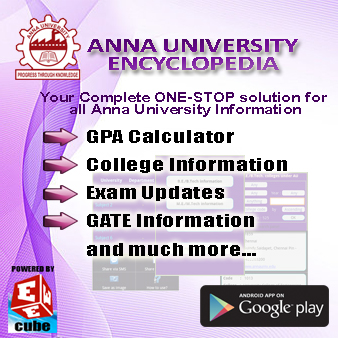SUBJECT RESOURCES:
CLICK HERE to access 'Previous year Question Papers'
CLICK HERE to access 'Question Banks'
CLICK HERE to access '2 Marks with answers'
CLICK HERE to access 'Notes'
CLICK HERE to search more about this subject
SYLLABUS:
EC2311 COMMUNICATION ENGINEERING L T P C
CLICK HERE to access 'Previous year Question Papers'
CLICK HERE to access 'Question Banks'
CLICK HERE to access '2 Marks with answers'
CLICK HERE to access 'Notes'
CLICK HERE to search more about this subject
SYLLABUS:
EC2311 COMMUNICATION ENGINEERING L T P C
3 0 0 3
AIM
To introduce the concepts of communication systems engineering using wire and wireless medium
OBJECTIVES
· To introduce different methods of analog communication and their significance
· To introduce Digital Communication methods for high bit rate transmission
· To introduce the concepts of source and line coding techniques for
enhancing rating of
transmission of minimizing the errors in transmission.
· To introduce MAC used in communication systems for enhancing the number of users.
· To introduce various media for digital
communication
UNIT I ANALOG COMMUNICATION 9
AM – Frequency spectrum – vector representation – power relations – generation of AM – DSB,
DSB/SC, SSB, VSB
AM Transmitter
&
Receiver; FM and PM –
frequency spectrum –
power relations : NBFM & WBFM, Generation of FM and DM, Amstrong method & Reactance modulations : FM & PM frequency.
UNIT II DIGITAL COMMUNICATION 9
Pulse modulations – concepts of sampling and sampling theormes, PAM, PWM, PPM, PTM, quantization and coding : DCM, DM, slope overload error. ADM, DPCM, OOK systems – ASK, FSK, PSK, BSK, QPSK, QAM, MSK, GMSK, applications of Data communication.
UNIT III SOURCE CODES, LINE CODES & ERROR CONTROL (Qualitative only) 9
Primary communication – entropy, properties, BSC, BEC, source coding : Shaum, Fao, Huffman coding
: noiseless coding theorum, BW – SNR trade off codes: NRZ, RZ, AMI, HDBP, ABQ, MBnB
codes : Efficiency of transmissions, error
control codes and applications: convolutions & block codes.
UNIT IV MULTIPLE ACCESS TECHNIQUES 9
SS&MA techniques : FDMA, TDMA, CDMA, SDMA application in wire and wireless communication :
Advantages (merits)
:
UNIT V SATELLITE, OPTICAL FIBER – POWERLINE, SCADA 9
Orbits : types of
satellites : frequency used link establishment, MA techniques used in satellite
communication, earth station; aperture actuators
used in satellite – Intelsat and Insat: fibers – types:
sources, detectors used, digital filters, optical link: power line carrier communications: SCADA
TOTAL : 45 PERIODS
TEXT BOOKS
1.Taub &
Schiling “Principles of communication systems” Tata McGraw hill 2007
2.J.Das “Principles of digital communication”
New Age International, 1986
REFERENCES
1. Kennedy and Davis “Electronic communication systems” Tata McGraw hill, 4th
edition, 1993.
2. Sklar “Digital communication fundamentals and applications“ Pearson Education,
2001
3. Bary le, Memuschmidt, digital
Communication, Kluwer Publication, 2004.
4. B.P.Lathi “Modern digital
and analog communication systems” Oxford University
Press, 1998.
|
|











No comments:
Post a Comment
Note: Only a member of this blog may post a comment.